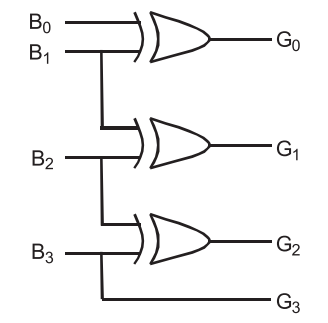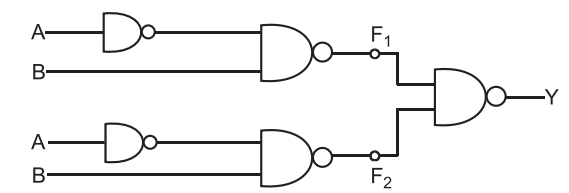Advanced Microprocessors
- Convert (205)10 = (x)16?
-
View Hint View Answer Discuss in Forum
16) 205 (12 → C
192
13 → D
So, (205)10 = (CD)16 = (x)16
Therefore, x = CD.Correct Option: A
16) 205 (12 → C
192
13 → D
So, (205)10 = (CD)16 = (x)16
Therefore, x = CD.
- The binary B3 B2 B1 B0 is to be converted to Gray code. The binary digit that does not require a gate for conversion is—
-
View Hint View Answer Discuss in Forum
Binary to Gray code converter is shown below:

From above figure w e conclude that B3 does not require any gate. Hence alternative (B) is the correct answer.Correct Option: B
Binary to Gray code converter is shown below:

From above figure w e conclude that B3 does not require any gate. Hence alternative (B) is the correct answer.
- How many NAND gates are required to make AB + BA?
-
View Hint View Answer Discuss in Forum

Y = AB + AB
This means, half adder requires 4 NAND gates. Hence alternative (C) is the correct answer.Correct Option: C

Y = AB + AB
This means, half adder requires 4 NAND gates. Hence alternative (C) is the correct answer.
- The 2 × 1 MUX having switching delay of 1μ sec connected as shown:

The output is connected to its own select switch. The output will be—
-
View Hint View Answer Discuss in Forum
Here switching delay means after 1 μ sec.,the switch is moved between the point A and B.

Hence, Time period = 2μ sec
∴Frequency = 1 = 0.5 MHz 2 μsec
Hence alternative (B) is the correct answer.Correct Option: B
Here switching delay means after 1 μ sec.,the switch is moved between the point A and B.

Hence, Time period = 2μ sec
∴Frequency = 1 = 0.5 MHz 2 μsec
Hence alternative (B) is the correct answer.
- Write output—

-
View Hint View Answer Discuss in Forum

F1 = (AB)′
F2 = (BA)′
Y = F1F2 = [( AB)′ ( BA)′]′
= [(A + B′) ( B + A)] ′ = AB + BA
Alternative Method:
NAND-NAND circuit can be replaced by AND-OR Hence,
Now, F1 = AB,
F2 = BA
Y=F1 + F2 = AB + BA (this is shortcut method).Correct Option: D

F1 = (AB)′
F2 = (BA)′
Y = F1F2 = [( AB)′ ( BA)′]′
= [(A + B′) ( B + A)] ′ = AB + BA
Alternative Method:
NAND-NAND circuit can be replaced by AND-OR Hence,
Now, F1 = AB,
F2 = BA
Y=F1 + F2 = AB + BA (this is shortcut method).

